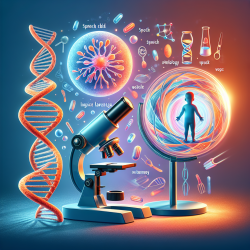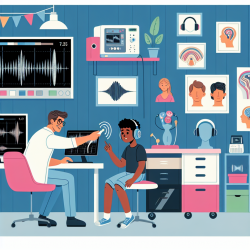Introduction
In the ever-evolving field of speech-language pathology, staying informed about genetic disorders that may impact communication is crucial. One such disorder is the Autosomal Recessive Keratoderma-Ichthyosis-Deafness (ARKID) syndrome, which is linked to VPS33B mutations. This blog delves into the recent findings from the research article titled "Autosomal Recessive Keratoderma-Ichthyosis-Deafness (ARKID) Syndrome Is Caused by VPS33B Mutations Affecting Rab Protein Interaction and Collagen Modification," and explores how practitioners can leverage this knowledge to improve outcomes for affected children.
Understanding ARKID Syndrome
ARKID syndrome is characterized by a combination of palmoplantar keratoderma, ichthyosis, and sensorineural deafness. The research highlights the role of VPS33B mutations in disrupting Rab protein interactions and collagen modification, leading to the syndrome's clinical manifestations. These mutations impair the trafficking of the collagen-modifying enzyme LH3, which is crucial for maintaining skin integrity and auditory function.
Key Findings from the Research
- Genetic Basis: The study identified biallelic mutations in VPS33B, particularly the missense variant p.Gly131Glu, as the cause of ARKID syndrome.
- Protein Interactions: The mutations affect the interaction of VPS33B with Rab11a and Rab25 proteins, crucial for collagen modification and vesicular trafficking.
- Clinical Implications: Patients exhibit impaired epidermal structure and sensorineural deafness, correlating with the defective collagen modification and Rab protein interactions.
Implications for Practitioners
For speech-language pathologists, understanding the genetic underpinnings of ARKID syndrome can inform more effective intervention strategies. Here are some practical applications:
- Early Detection: Recognizing the signs of ARKID syndrome, such as skin abnormalities and hearing loss, can lead to earlier diagnosis and intervention.
- Collaborative Care: Working closely with geneticists and dermatologists can provide a comprehensive care approach, addressing both communication and physical symptoms.
- Targeted Interventions: Tailoring speech and language therapy to accommodate hearing impairments and potential cognitive delays can enhance therapy outcomes.
Encouraging Further Research
While the current research provides valuable insights, there is still much to learn about ARKID syndrome. Practitioners are encouraged to stay abreast of ongoing studies and consider participating in research initiatives. This not only contributes to the broader scientific understanding but also enhances clinical practice.
Conclusion
By integrating the findings from this research into clinical practice, speech-language pathologists can play a pivotal role in improving the quality of life for children with ARKID syndrome. For those interested in delving deeper into the study, the original research paper can be accessed here.










